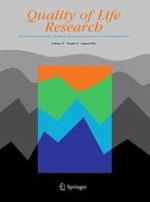24.12.2015
Drug persistence and compliance affect patient-reported outcomes in overactive bladder syndrome
Erschienen in: Quality of Life Research | Ausgabe 8/2016
EinloggenAktivieren Sie unsere intelligente Suche, um passende Fachinhalte oder Patente zu finden.
Wählen Sie Textabschnitte aus um mit Künstlicher Intelligenz passenden Patente zu finden. powered by
Markieren Sie Textabschnitte, um KI-gestützt weitere passende Inhalte zu finden. powered by
